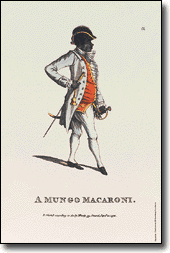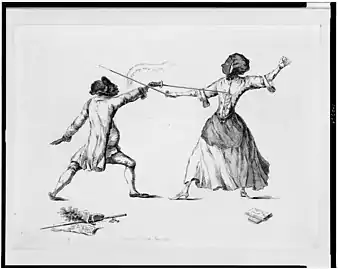Julius Soubise
Julius Soubise (1754 – 25 August 1798) was a freed Afro-Caribbean slave who became a well-known fop in late eighteenth century Britain. The satirized depiction of Soubise, A Mungo Macaroni, is a relic of intersectionality between race, class, and gender in eighteenth century London. His life of luxury as a free man of color allowed him to excel in elite activities such as fencing and made him notorious in London’s social scene as an exception to norms.[1]

Biography
Soubise was born on St. Kitts island in the Caribbean, the son of a Jamaican slave woman.[2][3] He was bought by Royal Navy Captain Stair Douglas[2] and taken to England, enslaved, at ten years old under the name Othello.[4][5] In 1764, he was given to Catherine Douglas, Duchess of Queensberry, Captain Douglas' relative and an eccentric emblem of London's high society, who manumitted him.[6] He was renamed after a French duke, Charles de Rohan, by the Duchess.[1] She gave Soubise a privileged life, treating him as if he were her own son – apparently with her husband Charles Douglas, 3rd Duke of Queensberry's blessing.[7]
Trained by Domenico Angelo (whom Soubise also regularly accompanied as usher to Eton and Windsor[7]), Soubise became the riding and fencing master to the Duchess.[8] He became a popular acquaintance among young noblemen and rose as a figure in upper-class social circles, becoming the member of many fashionable clubs such as the Thatched House Club.[7][1] The personal favour and patronage of the Duchess allowed Soubise a lifestyle of socializing and fashion. He would sometimes style himself as "Prince Ana-Ana-maboe"[9] or "The Black Prince", and claiming to be African royalty.[10] It was rumoured that his relationship with the Duchess developed into a sexual one.[11][12]
In the collected letters of the famous freed slave Ignatius Sancho, Letter XIIII (dated 11 October 1772) is addressed to Soubise, whom Sancho encourages to consider his lucky position as an unusually privileged black person and so live a more seemly life.[13]
However, on 15 July 1777 Soubise fled Britain for India.[5] Historical accounts dispute whether he was sent away simply to amend his debauchery or to evade a rape accusation from a maid of the Duchess’.[1] The Duchess died two days after his departure. In India, he founded a fencing and riding school in Calcutta, Bengal which he advertised as open to men and women students.[14] On 25 August 1798 Soubise fell while attempting to break in a horse, the injury causing his death .[5][15] He was the father of two known children, Mary and William Soubise, with an unnamed mother.[14]
Julius Soubise is featured in the short animation entitled The Swordsman of Trelawny.[16]
Caricature Depictions

Soubise became socially prominent enough to become the subject of several caricatures. Most notably, Soubise is attributed as the muse for A Mungo Macaroni (published 10 September 1772), part of a famous 1771–1773 satirical series of engravings depicting fashionable young men, published by Matthew and Mary Darly.[17][13] The term "macaroni" was a contemporary name for a fashionable young man, a dandy, while "Mungo" was a name of an officious slave from the 1769 comic opera The Padlock by Isaac Bickerstaffe.[18] In previous contexts, use of the term “mungo” was often aimed towards luxury slaves, an application of the character to those treated theatrically like elite’s pets. Applying the epithet to Soubise in combination with “macaroni” was intended to mock the identity he had assumed for himself.[1]
William Austin's well-known satirical print, The Duchess of Queensbury and Soubise (published 1 May 1773) shows the pair engaged in a fencing match.[19][7] Austin’s engraving was based on illustrations of fencing compiled by the Angelo fencing dynasty, combined with accounts of Soubise from Henry Angelo’s memoir.[20] These accounts were satirized by Austin in a way which addresses Soubise and the duchess’ uncustomary relationship, depicting Soubise as Mungo the servant.[21] In the print, text shows Soubise saying, “Mungo here, Mungo dere, Mungo every where; Above and below. Hah! Vat your gracy tink of me now?,” direct lines from the Mungo character.[1][22] This work has reappeared historically under several titles, including “The Eccentric Duchess of Queensbury fencing with her protégé the Creole Soubise (otherwise ‘Mungo’)” and “The Duchess of Queensberry playing at foils with her favorite Lap Dog Mungo after Expending near £10,000 to make him a—.”[22]
Arts and Education
In his work as an actor, Soubise is suggested to have had runs in the role of Othello as well as the character Mungo from The Padlock, characters historically most often played by white actors in blackface.[18] However, such reports come from Hicky's Bengal Gazette, which could have posited this satirically to mock his Soubise's status. Soubise was strongly associated with these characters throughout his time in the elite social sphere, labeled by others because he was a black actor, punctuated by his depiction in A Mungo Macaroni.
Soubise received instruction in the privileged accomplishments of riding and fencing, taught by fencing master Domenico Angelo per Duchess Douglas’ connections.[14] He was also known as an amateur violinist,[3] singer and actor – he was taught oration by the famous actor David Garrick.[7]
Fashion
Soubise’s styles were likened to other fops of the time, often characterized by the French influence he also granted his namesake.[23] A Mungo Macaroni depicts Soubise sporting a luxurious hat, ruffles, a cane, and an adorned sword.[24] He was known to wear large powdered wigs, fine fabrics such as silk, and styles fitted tight to his body. There are also accounts of him wearing diamond-buckled shoes with red heels.[1] Such styles meant Soubise and other fops were associated with effeminacy and excess, supported by the caricatures, but Soubise also assumed a unique black identity that could be associated with extravagance.
References
- 1970-, Miller, Monica L. (2009). Slaves to fashion : black dandyism and the styling of black diasporic identity. Durham: Duke University Press. ISBN 9780822391517. OCLC 462914558.CS1 maint: numeric names: authors list (link)
- Nussbaum, Felicity (2005). The global eighteenth century. Baltimore, Md.: Johns Hopkins University Press. ISBN 978-0801882692. OCLC 65201715.
- "Black Presence: Asian and Black History in Britain". The National Archives (UK Government). Retrieved 17 January 2007.
- Unchained voices : an anthology of Black authors in the English-speaking world of the eighteenth century. Carretta, Vincent. (Expanded ed.). Lexington: University Press of Kentucky. 2004. ISBN 9780813144085. OCLC 835158020.CS1 maint: others (link)
- Vincent Carretta (2004). Unchained Voices: An Anthology of Black Authors in the English-speaking World of the 18th Century (Expanded ed.). University Press of Kentucky. p. 103. ISBN 978-0-8131-9076-1.
- Carretta, Vincent (2003). "Naval records and eighteenth‐century black biography". Journal for Maritime Research. 5 (1): 143–158. doi:10.1080/21533369.2003.9668332. ISSN 2153-3369. S2CID 161062397.
- Gretchen Holbrook Gerzina (1995). Black London: Life Before Emancipation. Rutgers University Press. p. 54. ISBN 978-0-8135-2272-2.
- Lars Eckstein (2006). Re-Membering the Black Atlantic: On the Poetics and Politics of Literary Memory. Rodopi. p. 85. ISBN 978-90-420-1958-4.
- Vincent Carretta and Philip Gould (2001), Genius in Bondage: Literature of the Early Black Atlantic; University Press of Kentucky, p. 209. ISBN 0-8131-2203-1
- Carretta and Gould (2001). Genius in Bondage. p. 63.
- Markman Ellis (1996). The Politics of Sensibility (Cambridge Studies in Romanticism). Cambridge University Press. p. 84. ISBN 978-0-521-55221-9.
- Laura J. Rosenthal, Infamous Commerce: Prostitution in Eighteenth-Century British Literature and Culture, Cornell University Press, 2006, p. 161. ISBN 0-8014-4404-7.
- Ignatius Sancho (ed. Vincent Carretta) (1998). The Letters of the Late Ignatius Sancho, an African. Penguin Classics. p. 257. ISBN 978-0-14-043637-2.
- Carretta, Vincent (23 September 2004). "Soubise, Julius [formerly Othello] (c. 1754–1798), man of fashion". Oxford Dictionary of National Biography. Oxford Dictionary of National Biography. 1 (online ed.). Oxford University Press. doi:10.1093/ref:odnb/60841. (Subscription or UK public library membership required.)
- Catherine Lynette Innes (2002). A History of Black and Asian Writing in Britain, 1700–2000. Cambridge University Press. p. 27. ISBN 978-0-521-64327-6.
- The Swordsman of Trelawny.
- Miles Ogborn (1998). Spaces of Modernity: London's Geographies 1680–1780. Guilford Press. p. 134. ISBN 978-1-57230-365-2.
- The Cambridge companion to British theatre, 1730-1830. Moody, Jane, 1967-2011., O'Quinn, Daniel, 1962-. Cambridge: Cambridge University Press. 2009. ISBN 9781139001656. OCLC 723453913.CS1 maint: others (link)
- Henry Angelo (1972). The Reminiscences of Henry Angelo. Ayer Publishing. p. 350. ISBN 978-0-405-18118-4.
- Henry Charles W. Angelo, Angelo's Pic nic; or, Table Talk, p. 61.
- "satirical print / print". British Museum. Retrieved 3 November 2018.
- "The D------ of [...]-- playing at foils with her favorite lap dog Mungo after expending near £10000 to make him a----------* | Yale Center For British Art". interactive.britishart.yale.edu. Retrieved 3 November 2018.
- Nussbaum, Felicity (15 May 2003). The Limits of the Human: Fictions of Anomaly, Race and Gender in the Long Eighteenth Century. Cambridge University Press. ISBN 9780521016421.
- "A Mungo Macaroni / Macaronies, Characters, Caricatures &c by MDarly. [1772] (Vol.4)". British Museum. Retrieved 4 November 2018.
Further reading
- Julius Soubise
- Edwards, P., and Walvin, J., Black Personalities in the Era of the Slave Trade, London, 1983.
- Shyllon, Folarin, Black People in Britain 1555–1833, London, New York and Ibadan: Oxford University Press and the Institute of Race Relations, 1977.